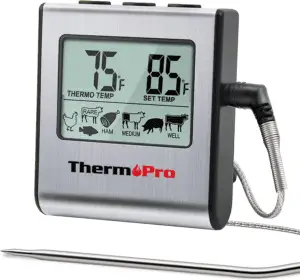Share via:
If you’re a proud owner of a Traeger pellet grill, you already know the convenience it brings to your grilling experience. But like any other appliance, it’s not immune to problems.

Among the issues you may encounter, thermostat issues are probably the most common and the most frustrating. But don’t worry! This article provides simple solutions with clear instructions to fix your Traeger thermostat problems.
Remember: A thermostat controls your Traeger’s temperature. If it’s malfunctioning, it may result in unevenly cooked food or a grill that refuses to heat up. But most thermostat issues are relatively easy to correct if you know what to do.
Before we get started, let’s take a quick look at the common Traeger thermostat problems we’ll be discussing:
- The thermostat not displaying the correct temperature
- The Traeger grill not getting hot enough
- Flashing temperature on the screen
- The thermostat not communicating with the grill
With each of these, we’ll provide an understandable solution that you should be able to tackle on your own. And, we’ll let you know if you need any extra tools or parts.
How Does Traeger Thermostats Works
You know that maintaining the right temperature is key to achieving that perfect sear on your steak, or slow roasting a brisket. Traeger thermostats, integrated into their top-of-the-line pellet grills, are designed to ensure precise temperature control.
The thermostat’s primary function is to regulate the temperature within the grill.
Once you set your desired cooking temperature on the thermostat, the pellet grill takes over from there. Its automated system begins by feeding pellets from the hopper into the fire pot. An igniter rod within the pot heats up, causing the pellets to catch fire.
The thermostat’s job really starts at this point. It monitors the temperature inside the grill. When the temperature dips below the preset level, it signals the auger to feed more pellets into the fire pot, raising the temperature.
Related >> 8 Reasons Why Traeger Auger Not Turning
Conversely, if the temperature rises above the set level, the system suspends the feeding of pellets, allowing the temperature to drop.
It is this automated control of temperature that makes Traeger pellet grills user-friendly. It allows you to “set it and forget it”, ensuring your meat is cooked at the right temperature for the right amount of time, every single time.
However, like with any automated system, problems can arise with Traeger thermostats.
We’ve put together a guide to help you understand these common problems and offer practical solutions to get you back to grilling in no time.
Common Traeger Thermostat Problems
1- Failure to Reach Desired Temperature
There may be times when your Traeger grill simply doesn’t heat to the desired temperature, despite your thermostat being set correctly.
This issue could result from various factors like a blocked fire pot or a malfunctioning hot rod.
Blocked or Clogged Firepot:
One common reason for temperature issues is a blocked or clogged firepot. Over time, ash and debris can accumulate in the firepot, obstructing airflow and preventing proper combustion. Start by turning off your grill and allowing it to cool down completely.
Once it’s cool, remove the grates, grease tray, and heat baffle to access the firepot. Using a specialized ash vacuum or a shop vac, carefully remove any ash or debris from the firepot.
Ensure it’s completely clear, as even a small blockage can hinder temperature regulation.
2. Check the Hot Rod
The hot rod is responsible for igniting the pellets in your grill. If it malfunctions, it can lead to issues with temperature control.
Inspect the hot rod for any visible damage, such as frayed wires or a burnt-out element. If you notice any problems, it may need to be replaced.
Replacing the hot rod is a relatively simple process, and Traeger usually provides detailed instructions in their manuals.
2- Temperature Readings On Traeger Thermostat Not Accurate
Sometimes, you may notice that the temperature reading on your Traeger thermostat doesn’t match the actual temperature inside your grill. This issue could be due to sensor problems or an improperly placed temperature probe.
Make sure that the temperature probe is correctly positioned in the thickest part of your food, avoiding bones. You can also use an independent meat thermometer for verification.

Here is a guide on how to use the Traeger meat probe
The temperature sensor inside the grill can give inaccurate readings because of residue buildup. Inspect and clean the sensors and, use multiple thermometers to monitor individual food items.
3- Temperature Fluctuations
If your Traeger pellet grill temperature fluctuates wildly, it can significantly affect the quality of your cooked food. Because consistent temperatures are critical for perfect barbecuing.
This problem might stem from issues like poor heat insulation, windy conditions, or a faulty fan. Start by assessing your grilling environment, ensuring it’s shielded from strong winds and appropriately insulated.
Check the fan. A faulty fan in a Traeger pellet grill refers to a malfunctioning or damaged combustion fan or draft induction fan, which plays a crucial role in regulating temperature and maintaining consistent heat within the grill.
These fans are responsible for supplying oxygen to the fire, controlling the burn rate of pellets, and distributing heat evenly throughout the cooking chamber.
4- Difficulty in Igniting the Grill
If your grill doesn’t ignite properly or at all, there may be an issue with the ignitor rod, or the grill may not be receiving adequate ventilation.
Poor power supply to your Traeger grill can also prevent it from igniting. The ignitor rod is responsible for lighting the pellets in your Traeger grill. If it’s malfunctioning or dirty, it can lead to ignition problems.
To address this, first, make sure the ignitor rod is clean and free of debris. You can gently clean it with a soft brush or cloth. If cleaning doesn’t solve the issue, the ignitor rod may need replacement.
5- Poor Heat Distribution
A good grill should distribute heat evenly throughout its cooking surface. If your food is cooking unevenly, there may be an issue with the grill’s heat distribution systems, potentially caused by a blockage or malfunction.
Inspect the heat diffuser plate. The heat diffuser plate, also known as the heat shield or heat deflector, plays a crucial role in spreading heat evenly. Check for any blockages or buildup on the heat diffuser plate.
6- Thermostat Display Malfunction
Your thermostat display is crucial for monitoring and adjusting your grill’s temperature. If it’s not functioning correctly, you may be cooking blind.
A faulty display could result from an electronic glitch, a wiring issue, or a damaged LCD. To address display issues, start by ensuring a secure power connection, performing a soft reset cycle, and inspecting wiring for damage.
Why Is My Traeger Grill Offline? (Reset Traeger WiFIRE)
7- Problems with Power Supply
Without a proper power supply, your Traeger grill cannot function. Issues such as power fluctuations or power supply present problems for the proper working of the thermostat.
A damaged power cord or power outlet could also contribute to this issue.
Troubleshooting Traeger Thermostat Problems
Let’s dive into troubleshooting Traeger thermostat problems. These steps will help you identify common issues and provide you with practical solutions. You don’t need to be an expert to do these – just follow along!
1. Check the Power Source
Before jumping to conclusions, first, make sure that your grill is correctly plugged in, and the outlet is working properly.
A simple way to check this is by testing the outlet with another device. If that device works, then the issue is likely with the grill itself, not the power supply.
Note: If you’re using an extension cord, ensure it’s of good quality and capable of handling the grill’s power requirements.
2. Clean the Grill and Thermostat
A dirty grill can cause numerous issues and might be the culprit stopping your thermostat from functioning correctly.
Clean all parts of the grill properly, paying extra attention to the thermostat. Dust and grease buildup can affect its performance.
Make sure the temperature probe in the grill is free of ash and other debris. Always remember, cleanliness is key!
3. Calibrate the Thermostat
If you notice that the readings from the grill do not match an external thermometer, it’s probably time to calibrate your thermostat. Refer to your user manual for specific instructions on how to calibrate your specific Traeger model.
Ensuring your thermostat is correctly calibrated can enhance the accuracy of the temperature control.
4. Inspect and Replace Damaged Components
Over time, wires and other components may wear out or even become damaged. Inspect your grill for any visible damage, such as frayed wires, and replace any damaged parts as required.
Using a grill with damaged parts not only affects performance but can also be hazardous.
5. Reset the Thermostat
Like any other electronic device, your grill’s thermostat may need a good reset now and then, particularly if it’s acting up.
Again, refer to your manual for specific instructions. A reset can often clear any minor glitches and restore normal operation.
6. Upgrade the Firmware
Some Traeger grills come with Wi-Fi technology and the ability to download firmware updates from the manufacturer.
These updates can help correct any bugs or issues the thermostat may be experiencing. So, if you’re struggling with persistent problems, it’s worth checking whether an update is available.
7. Contact Traeger Customer Support
If all else fails, it’s time to call in the experts. Contact Traeger’s customer support center. It’s staffed with individuals who are deeply familiar with the product and will be able to provide help tailored to your specific situation.
Wrap Up
Troubleshooting problems can be a process of trial and error, but with some persistence and a bit of patience, you’ll likely be able to get your Traeger to grill back to optimum performance.
Here are the essential points that you need to remember:
- Thermostat problems can compromise the efficiency of your Traeger grill.
- Knowing the common issues and their solutions can help you maintain the overall performance of your unit.
- Regular and proper maintenance of your Traeger grill can prolong its lifespan.
If you’ve tried it all and your grill still isn’t functioning properly, it may be time for a more significant repair – or even a replacement.
Related Articles That You’ll Love To Read
8 Traeger Super Smoke Hack
Traeger Smoke Setting: Low and Slow Cooking
Traeger Uneven Heat: Reasons and Solutions
How to Restart Traeger After Power Outage [6 STEPS]
FAQs
How do I adjust my Traeger thermostat?
Adjusting the thermostat on your Traeger grill is a straightforward process.
- Turn on the Grill: Ensure your Traeger grill is plugged in and powered on. You should hear the startup fan blowing to circulate air.
- Access the Control Panel: Locate the control panel on your grill. The location may vary depending on your specific Traeger model, but it’s usually on the hopper side.
- Select Temperature: On the control panel, you’ll find temperature settings. These can be adjusted using a dial or digital buttons, depending on your grill’s model. Use the “+” and “-” buttons or turn the dial to select your desired temperature. Traeger grills typically have a wide range of temperature settings, so choose the one that suits your cooking needs.
- Set the Temperature: Once you’ve selected your desired temperature, confirm the setting. Your Traeger grill will now start the ignition process, and the auger will feed pellets to the fire pot accordingly.
- Monitor the Temperature: Keep an eye on the temperature display. It will show you the current temperature inside the grill. Traeger grills are known for their consistency in maintaining set temperatures.
- Make Adjustments: If you find that the temperature inside the grill is not aligning with your desired setting, you can make minor adjustments by increasing or decreasing the temperature setting as needed.
It may take a little time for your Traeger grill to reach and stabilize at the selected temperature, especially if you’ve made adjustments. Some external factors like weather conditions can affect the grill’s performance, so some occasional monitoring may be necessary to maintain your desired cooking temperature.
I am a writer, editor, and publisher of Grillcuisines.com – an online blog dedicated to sharing grilling tips, accessories, and recipes to encourage more people to get outside and grill.
I’m off to find out the different types of grill foods, their seasons, and how to conduct outdoor cooking properly. I’ll also show you some of my grill-worthy cooking tools & accessories!




